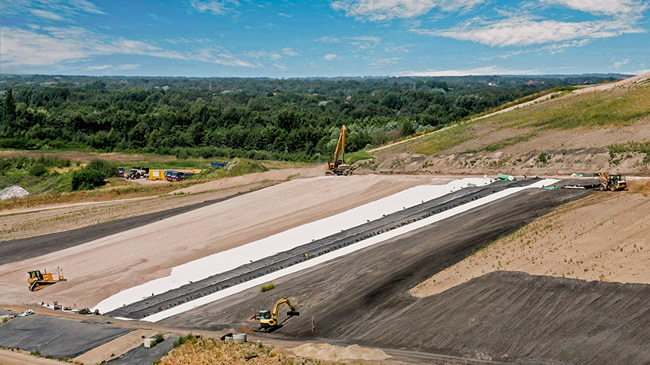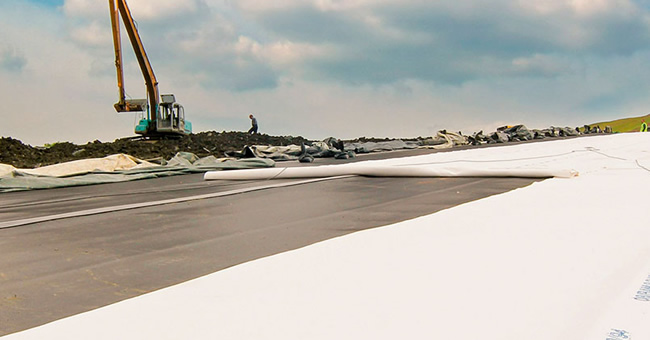The field of geosynthetics has often been defined by how these materials improve the performance and economics of a particular site or application. One of the ways that geosynthetics achieve such goals is through rigorous testing to ensure proper selection of a material. However, engineering approaches are often driven by a market’s level of infrastructure development and regulatory readiness. This can lead to some stark differences in how geosynthetics, or other materials, are qualified for acceptance on a site or in an engineering sector. For this episode of Geosynthetica’s GeoTalk Podcast, we talked with Kent von Maubeuge (NAUE Geosynthetics) about this, with respect to how puncture protection is approached for landfill lining systems around the world.
Listen to “Varying International Perspectives on Landfill Puncture Protection” on Spreaker.
GeoTalk is published on Tuesdays. Recent episodes:
- July 25: Jorge Zornberg on Differing MSE Design Frameworks
- July 18:George Koerner on Exposed Geomembrane Performance
- July 11: Pullout Anchor Testing in Erosion and Sediment Control
- July 5:Effective Education for Erosion and Sediment Control System Adoption
Subscribe on iTunes and in the Google Play store.
See the end of this article for links to puncture protection resources.
PUNCTURE PROTECTION FOR LANDFILL LINING SYSTEMS
Granular material in a landfill lining system could potentially damage a geomembrane and lead in the long term to leakage in the system. Geotextile puncture protection guards against this damage. How this is approached is not standard around the world. The US and Europe, for example, have what Kent von Maubeuge (NAUE Geosynthetics) calls a severe difference.

“The American approach is on a theoretical approach. You measure tensile strength of the membrane or puncture resistance of that system,” von Maubeuge says. “You back-calculate from that hole to decide on what is the mass per unit area needed for the geotextile in that situation.”
The European approach, in contrast is heavily based on site-specific conditions, including conducting tests with samples of the actual granular material to be used on used.
“The European approach is to take the realistic conditions from the site—it’s a site by site approach, not an index test,” he says. “The only non-natural material in the test is a rubber to duplicate the clay (because clay doesn’t test well this way) and you use actual granular material from your site.”
The big difference comes in accounting for potential deformation. In Europe, you cannot accept more than a 0.25% deformation, for it would indicate that across the enormous span of a geomembrane installation that you might develop a 3% deformation somewhere in the system.
NO NEED FOR ALARM
Von Maubeuge reminds us that none of this is to suggest one part of the world is choosing a dangerous path in its engineering. For international geosynthetics work, though, these differences impact the decisions that consultants, manufacturers, and other stakeholders make.

Australia may engineer its landfills very similarly to what is done in Europe, but in Malaysia the standards are very different because the market is not developed enough to use the same standards as in Europe of the US.
One of the reasons to pay attention to this, von Maubeuge notes, is that the differing regional approaches may seem to counter the larger movement in the geosynthetics field to support geotechnical engineering with a consistent message. Knowing how and why one region uses Approach X while another uses Approach Y, and being able to convey those differences, is a strong way for the geosynthetics field to continue distributing useful, accurate, technically sound engineering information.
Puncture protection for landfill lining systems is just one of the areas in which this international discussion is developing, often from different angles but with one clear goal: better infrastructures and environmental performance.
PUNCTURE PROTECTION RESOURCES
Kent von Maubeuge’s paper on “Protection Geotextiles for Geomembranes in Landfill Applications” is available from ASCE in its e-book Geotechnical Frontiers 2017: Waste Containment, Barriers, Remediation, and Sustainable Geoengineering.
Germany’s Federal Institute for Materials Research (BAM) has made its Guidelines for the Certification of Protection Layers for Geomembranes in Landfill Sealing Systems available in English.
The GeoEngineering Centre in Canada, which is a joint venture between geotechnical engineering researchers at Queen’s University and the Royal Military College, has an excellent paper library from its extensive geosynthetic barriers research. One of the sections on it of interest to puncture protection is the “Effect of protection layers on strains in GMs with and without wrinkles under load and deformations in GCLs” section.
**
For more information on NAUE Geosynthetics engineering expertise and materials, visit www.naue.com.
We also recommend the International Geosynthetics Society (IGS) website for additional resources, such as members-only access to a library of papers (1800+): www.geosyntheticssociety.org.











